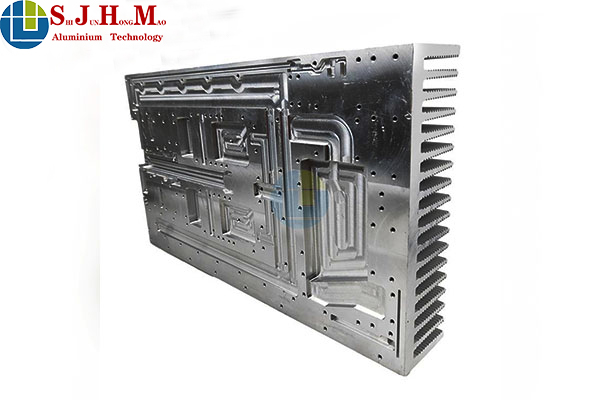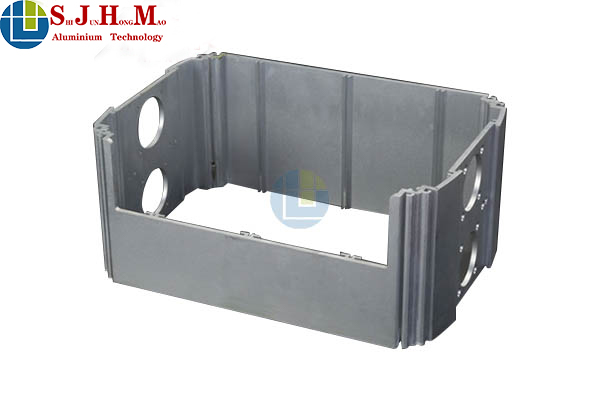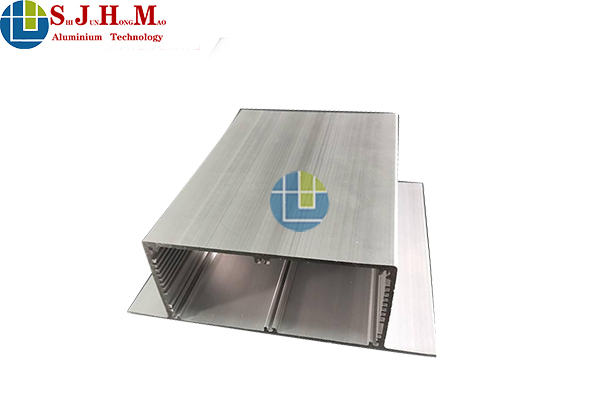What Are The Related Contents Of Precision CNC Deep Processing Of Industrial Aluminum Profiles?
- By:sjhmalu
- Date:22-09-2022
What are the precautions for CNC lathe processing of aluminum parts?
CNC lathes have a variety of raw materials for processing commodities. Among them, aluminum is one of the most machined parts. When using CNC machine tools to process aluminum parts, if you want to make the processed models and specifications more stable, you must pay attention to the refrigeration of raw materials in these places. Aluminum die-casting parts may be deformed after refrigeration. Such things are generally unavoidable. At this time, try to pay attention to the application of diesel engine refrigerant, and also consider it when making accurate measurements of power. When the raw material deforms, it deforms too. Our company’s control of details is very strict, precision deep processing. Let’s take a look at the precautions for CNC lathe processing of aluminum parts.
Basic parameters: Cutting speed, cutting coefficient, tool compensation, etc. are all cutting factors that affect processing efficiency, and special attention must be paid.
·Stress field level
Aluminum is too soft, so pay attention to the clamping range as much as possible. In addition, during machining, aluminum parts are rough-machined intact and left for a period to relieve stress fields before proceeding to the next production step. In addition, during the processing of aluminum parts, it is also necessary to pay attention to the requirements of the milling surface and cutting fluid. Many factors affect the efficiency of aluminum processing, so it must be handled flexibly during processing, and practical problems must be deeply analyzed. Stable machine tools, efficient machining processes and tools, and the technical competence of the operators are all factors that affect product quality.
·Tool selection
When processing aluminum parts, try to use special tools, which are generally more targeted. For example, turning tools used for aluminum milling generally have larger rake and helix angles, and sharper cutting edges, which are more conducive to the processing of aluminum parts (such as preventing chip accumulation), and their processing performance will be stronger. In addition, special attention should be paid to the difficulty of milling and the amount of cutting fluid required for machining aluminum parts. Many factors affect the reliability of aluminum processing, so it should be handled flexibly during processing, and specific difficulties should be analyzed in detail. Stable machine tools, reasonable processing technology and tools, and the technical level of operators are all factors that endanger product quality.
·Processing technology
Unreasonable processing technology can easily cause errors in the specifications and models of iron castings. In ensuring the basic processing technology (such as CNC machine tools cutting most of the basic processing technology key links such as “first rough and then fine, the first face and then hole, first more and then hot” or “minimize the number of clamping, forming tooling fixtures” and other key links in Using the fixture tooling), we must try our best to reduce the machining error caused by the iron pin on the aluminum part.
There are many reasons for the deformation of aluminum parts, which are often related to raw materials, parts appearance, production and processing specifications, etc. There are mainly several aspects: deformation caused by blank welding stress, and deformation caused by blank welding stress. Cutting force and heat of cutting, and deformation due to clamping force.

What are the main problems in the CNC machining of aluminum profiles?
Aluminum parts are one of the most widely processed applications in CNC hardware parts processing. For example, aluminum alloys are often used in our engineering, and magnesium alloys are commonly used in aircraft. They can be seen in the field of technology, digital electronics, and electrical appliances in daily life, and the manufacturing of vehicles. How to make products more stable and accurate in mass production, then what problems should we pay attention to when processing aluminum parts with CNC machine tools?
1. The state of the machine tool and the performance of the machine tool determine whether the product processing is stable or not. New machines are not dimensionally stable. Then we can not put it into use immediately when we purchase new machinery and equipment. It must be put into production after a reasonable and correct debugging (the servo motor, lead screw, nut, and other parts should be checked and the machine tool should be debugged).
2. After the workpiece is cooled, it may be deformed due to material cooling problems. Use special coolants or emulsifiers for aluminum machining.
3. Unreasonable processing technology and process settings will affect the dimensional accuracy of the workpiece. Controlling the force during clamping can also improve the clamping method of aluminum profiles. To ensure the basic machining process, the combined fixture should be used as much as possible. On this basis, the machining error formed by the iron filings on the aluminum parts must be minimized.
4. Aluminum profiles are softer than other materials such as steel and iron. The setting of cutting parameters is also very important. If the cutting speed is too fast, it will cause many problems. At the same time, special attention needs to be paid to the clamping force because aluminum is relatively soft.
5. Tool selection, cutting force of turning tool, and material have an impact on the cutting of processing materials. Therefore, it is necessary to choose the tool reasonably. The surface of aluminum parts made by special milling cutters will be better.
Common problems and solutions when CNC wire cutting aluminum parts
When CNC wire cutting aluminum parts, there are often problems such as serious wear of the feeder block, short circuit, broken wire, distortion of the processing track, and deformation of the workpiece, and some directly cause the processed products to be scrapped.
The problem of wire-cut aluminum parts easily broken
·Reasons why wire-cut aluminum parts are easy to break
When wire-cutting aluminum parts, due to the soft material, it is difficult to remove chips, and aluminum is easy to form a hard oxide film at high temperature, and a large amount of aluminum oxide or aluminum chips easily adhere to the molybdenum wire, which makes the molybdenum wire and the feeder block. Deep grooves are quickly ground at the contact area. Soft aluminum and hard abrasive particles are mixed, filling the grooves. Once brought in, the grooves will be squeezed to death, and the wire will be stuck.
·Solution
Aiming at the problem that the molybdenum wire is stuck in the feeder block and breaks the molybdenum wire, adjust the position of the upper and lower wire frame feeder blocks to prevent the worn groove of the feeder block from causing the wire to break and cause low efficiency and many machining surfaces. Quality loss and material waste are caused by secondary cuts.
The problem of workpiece deformation
·The reason for the deformation of the workpiece
Due to the uneven heating, internal microstructure transformation, and stress deformation of the workpiece blank during manufacturing, cutting, and heat treatment, residual stress is generated inside the workpiece. The stress distribution is relatively balanced without being affected by the outside world for some time. During the wire cutting process, because the workpiece material is cut and cut off in large quantities, its stress distribution will change, and it will gradually become balanced over time, thereby causing the workpiece to deform. This deformation phenomenon is more obvious for aluminum alloy parts.
· Solution
(1) Stress relief before cutting The parts are first heat treated to eliminate the internal stress of the material before cutting so that there will be no large stress deformation during cutting to stabilize the size. Of course, different materials have different processing methods.
(2) Outer contour processing method When machining the outer contour, it is usually possible to cut in from the outside of the blank without punching a wire hole. This method is very easy to cause a large deformation of the material due to the release of the internal stress after the blank is broken, resulting in a decrease in the machining accuracy of the parts. . To avoid and reduce the occurrence of this kind of deformation, the method of punching wire holes can be used to maintain the closedness of the blank outline.
(3) Use the secondary cutting method For parts with high machining accuracy requirements, it is best to use the secondary cutting method.

The problem of easy short circuit and cutting track distortion when cutting aluminum parts
·Analysis of the cause of the problem
In daily processing, it is more difficult to cut large-thickness workpieces. Because of the constraints of EDM erosion conditions, the workpiece is thick to a certain extent, there is not enough coolant to enter the workpiece, the electrolytic corrosion products in the gap cannot be removed normally, and the processing is very unstable. , until a short circuit with current and no discharge occurs, which is more likely to occur when cutting and processing aluminum parts.
Generally, the wire cutting machine tool has a short circuit protection function. Once a short circuit occurs, the machine tool table immediately stops moving and remains in place for processing. However, when machining aluminum parts, due to the lightness, softness, and difficulty of chip removal, the discharge point is sometimes transferred from the machining area to the feeder block after a short circuit, resulting in spark discharge between the feeder block and the molybdenum wire. The electrode wires are in a short-circuit state, but the discharge state of the machine tool is expected, so the machine tool will not realize short-circuit protection due to the short circuit between the workpiece and the molybdenum wire. At this time, the machine tool is still cutting and processing according to the normal procedure, and the workpiece cannot be processed due to no discharge at the processing place. In normal shape and size, only molybdenum wire is used to pull out the groove on the softer aluminum workpiece, which causes the distortion of the cutting trajectory and causes the workpiece to be scrapped.
· Solution
(1) The first is to optimize the process parameters. Set different wire cutting parameters according to different thicknesses. Through many experiments, it has been found that the pulse width can be appropriately reduced when processing aluminum alloy materials. This is because the pulse width is reduced, the single pulse discharge energy is reduced, the discharge trace is also small, and the size and number of alumina particles can also be reduced. , effectively reducing the wear of the feeder block. Relatively increasing the pulse gap is conducive to chip removal, reducing sticking, improving cutting stability, and improving the surface roughness of the workpiece. If the pulse gap is too small, the discharge products will not be removed in time, and the discharge gap will not have time to deionize, which will make the processing unstable and easily cause wire breakage or cutting track distortion.
If the set feed speed is lower than the actual possible erosion speed of the workpiece, the machining state will be open and the cutting speed will be slow. And due to the low melting point and vaporization point of the aluminum alloy, the processing erosion amount of the same discharge energy is increased, so the discharge gap is large. Due to the large discharge gap, the pulse voltage cannot break down the liquid medium between the electrodes in time, which greatly reduces the utilization rate of the pulse. At the same time, if the distance between the electrodes is too large, the amplitude of the electrode wire will increase, making the processing unstable, and even causing the wire to break. . When the set feed speed is greater than the actual possible erosion speed of the workpiece (called over-tracking or over-feed), it is easy to short-circuit during processing, and the actual feed and cutting speed also decrease, and the electro-erosion of aluminum is not used. , resulting in broken wires and short circuit suffocation. Therefore, the frequency conversion feed should be reasonably adjusted to achieve a better processing state. The entire variable frequency feed control circuit has multiple adjustment links, most of which are installed inside the machine tool control cabinet and should not be changed. Another adjustment knob is installed on the console operation panel. During processing, the knob can be set in a suitable position according to the specific situation to ensure the stable reading of the ammeter and the voltmeter, the molybdenum wire jitter is small, and the processing is in the best tracking state.
For example, when processing thick workpieces, generally at the beginning of processing (5mm), because the electrode wire is easy to shake and the coolant concentration is high, the energy of a single pulse should be increased, and the pulse interval should be increased. At least the ratio of pulse width to pulse interval is (1: 8), this is mainly to ensure that there is enough single pulse energy and enough interval time to remove the galvanic corrosion products, and at the same time reduce the processing current, generally less than 2A. When the processing is stable, the pulse interval is reduced accordingly, the processing current is increased by about 3A, and the voltage is about 75V. The purpose is that the average value of the current carrying capacity of the molybdenum wire can form the ability of spark discharge without increasing the premise, and the explosive force of the spark is enhanced. Therefore, the electrical parameters should be appropriately larger, otherwise, the machining will be unstable and the quality of the machined parts will decrease.
The requirements of cutting speed and surface roughness are two contradictory process indicators. Therefore, high cutting speed must be pursued on the premise of satisfying surface roughness.
(2) Select the appropriate discharge gap according to the thickness of the workpiece. The discharge gap should not be too small, otherwise, it is easy to cause a short circuit, which is not conducive to cooling and the discharge of electro-corrosion; if the discharge gap is too large, it will affect the surface roughness and processing speed. When cutting workpieces with large thicknesses, molybdenum wire with a large diameter and large pulse width current should be selected as far as possible to increase the discharge gap, enhance the chip removal effect and improve cutting stability.
(3) To maintain the cleanliness of the coolant, replace the new coolant in time, and use a filter at the return port of the coolant on the workbench to filter the impurities of the coolant, and then put a layer of sponge on the outlet of the coolant to absorb the coolant. impurities, the effect is very good. To improve the chip removal ability and prevent the deformity of the machining track, detergent and soap bars can also be added to the coolant, so that the washing performance becomes better, the chip removal ability increases, and the chip removal state is improved. At the same time, it is necessary to rotate and adjust the position of the feeding block in time or replace it with a new feeding block, and often clean the chip particles at the feeding block, keep good contact between the molybdenum wire and the feeding block, and avoid the discharge phenomenon there. , which can effectively avoid the distortion of the cutting track and cause the workpiece to be scrapped.
Starting from the actual operation of wire cutting processing, it is analyzed that when processing aluminum parts, alumina particles are easily generated, resulting in decreased electrical conductivity, wear of feeder blocks, broken wires, short circuits, etc., which seriously affect the processing quality and efficiency. Summarize the problems and solutions that often arise in practice. These methods and measures are practical and feasible and have a good effect on improving the quality of wire cutting, reducing wire breakage, short circuit, and distortion of the cutting track of processed aluminum parts.
How much do you know about CNC aluminum product processing?
Aluminum alloy precision parts and products are popular because of their lightweight and beautiful appearance, and they are more and more widely used in industrial and daily necessities. Especially in recent years, with the development of science and technology and the progress of society, people’s demand for product diversity is getting stronger and stronger. Therefore, the better the processing technology of aluminum alloy products, the more popular they will be, the greater the market demand, and the higher the income. CNC machining is one of the best machining methods for aluminum alloy shell products.
To meet people’s demand for the diversity and high quality of aluminum alloy shell products, it is necessary to summarize the processing skills during the processing. Based on years of CNC machining experience, our company has outlined the processing skills that should be paid attention to in the processing of aluminum alloy shells.
CNC machining skills require that the control system can logically process the program specified by the control code or other symbolic instructions and decode it by the computer so that the machine tool can move and process the part. The blank is processed into semi-finished products, etc. by tool cutting.
CNC cutting is to cut. For aluminum alloy precision machining, a more reasonable processing method is also a common processing method. It uses end mills with multi-directional cutting capabilities, helical cutting interpolation, and contour cutting interpolation. It uses some tools to perform a small number of holes. processing.
The ball end mill combined with the helical interpolation method can be used for continuous processing of tapered holes; the ball end mill and the helical interpolation drill can be used for boring and chamfering processing; it can be used for semi-precision machining of holes and precision parts machining; Threaded end mills and helical interpolation methods can be used to machine a variety of threaded holes.
Tool interpolation can be used when machining high-efficiency aluminum alloy precision parts for high-precision holes of any size. Especially when using high-speed milling, the load on each tooth is relatively small, so high-speed and high-precision hole machining of various machining materials is possible using the same coated carbide end mill.
In the process of CNC machining aluminum alloy shells, it is necessary to master processing technology and painting skills.
Select a reasonable cutting amount, and the staff will choose the cutting speed to be used according to the material to be processed, hardness, cutting state, material type, cutting depth, etc. These conditions are necessary to effectively reduce machine wear.
Choose the right tool. Generally speaking, when roughing, it is best to choose a tool with high strength and durability to better meet the requirements of roughing.
Choose a reasonable light fixture. The parts should fully meet the needs of the machine to reduce unnecessary positioning errors, so it is best to choose special jig clamping tools.
Determine a reasonable processing route. Try shortening the machine path to reduce machine wear.
In the actual machining and production process, the application of these mature CNC machining experiences has greatly improved the quality of CNC machining and the quality of aluminum alloy casings. Our company has explored and summed up the effective machining experience and skills in the CNC machining of aluminum alloy casings for sixteen years. In the actual machining and production process, the application of these mature CNC machining experiences has greatly improved the quality of CNC machining and the quality of aluminum alloy casings.

What are the characteristics of custom processing of aluminum profile parts?
Nowadays, more and more aluminum profiles appear in our lives, and people’s demand for aluminum profiles is also increasing. Aluminum profiles are loved by all walks of life because of their characteristics, but in applications, when industrial aluminum profiles cannot meet When the production requirements of the factory, special customization is required. So why choose custom processing of aluminum profiles, what is there to say? What are the advantages of custom processing aluminum profiles?
Advantages of custom processing of aluminum profiles
·The mold opening customization mode of aluminum profiles is more accurate: the corresponding mold customization has different sizes and technical standards, and users can send the drawings of the corresponding profiles to the processing manufacturers according to different needs. At the same time, the mold-making customization of industrial aluminum profiles can make the production related to the customized processing of aluminum profiles more refined and the product texture better.
·The machining accuracy and process are more reliable: precise machining methods and advanced instruments greatly improve the production effect. In the process of mold opening and customization of aluminum profiles, the characteristics of product design will be reasonably considered, which can be customized according to the user’s price and psychological expectations. Molding and customization of aluminum profiles can show better processing results.
In short, in the process of custom processing of aluminum profiles, aluminum profile manufacturers will provide corresponding service solutions according to the needs of users, formulate more professional and better product production standards according to the needs of users, and can use their technology in the production process. The model and customization requirements are improved; the aluminum profile customization process makes the integrity and creativity of the product structure and shape bring outstanding application effects.
About CNC deep processing of industrial aluminum profiles
The deep processing methods of industrial aluminum profiles include rolling, extrusion, drawing, and forging. However, in the deep processing of industrial aluminum profiles, to ensure the accuracy of the machine tool, the higher the better, the static bearing spindle is usually used. The tools used must be solid diamond-like tools after grinding. The cutting fluid can then be used directly with the emulsion for mirror finishing. The deep processing of the aluminum products treated by the latter is heat treatment, which is called the heat treatment of the finished product. Such treatments include finish annealing, solution treatment, quenching, natural aging, and artificial aging. At present, there are graded aging and deformation heat treatment processes. Artificial aging treatment can not only improve the mechanical properties of aluminum products but also improve the stress corrosion resistance and fracture toughness of aluminum products.
Technical support is also required during the production process. The technical support required for the deep processing of industrial aluminum profiles is as follows:
·Not dirty. For industrial aluminum profile blanks, the surface color should be the same and not dirty.
·The mechanical properties of industrial aluminum profiles meet the requirements of the national standard.
·After the surface oxidation treatment of industrial aluminum profiles, the color and brightness are uniforms, and there is no dirt.
·The length and size of industrial aluminum profiles should be implemented according to the technical requirements in the order contract between the supplier and the buyer.
·The technical development requirements of industrial aluminum profiles are not required by the technical engineering department to provide graphic information technology research data management.
·The surface treatment should be more in line with the quality management requirements stipulated by the current laws of our country. The indoor aluminum is sprayed with electrostatic powder, and the outdoor can use fluorocarbon spraying technology to deal with the lifestyle. The spraying color should ensure that it does not fade or fall off.


